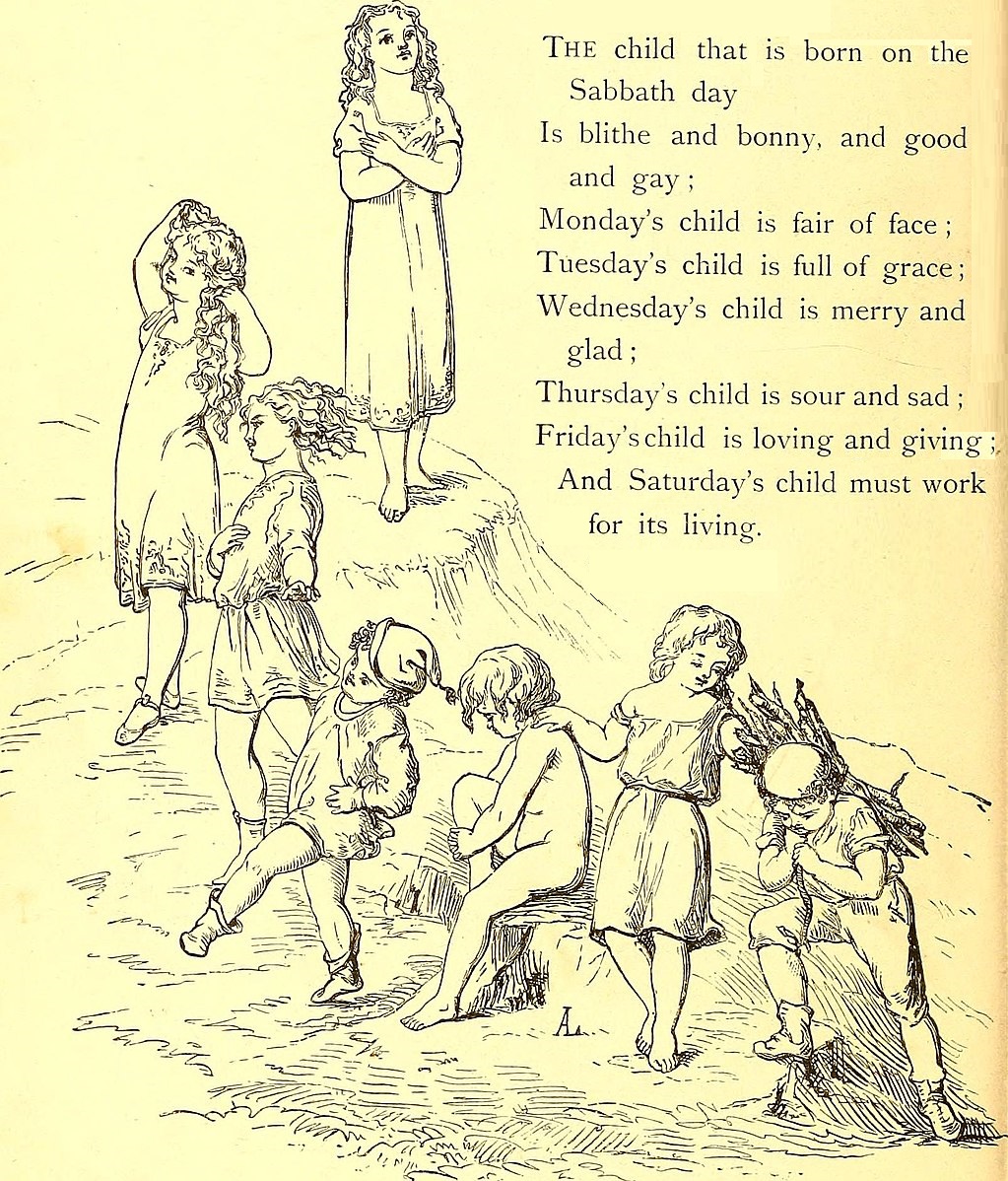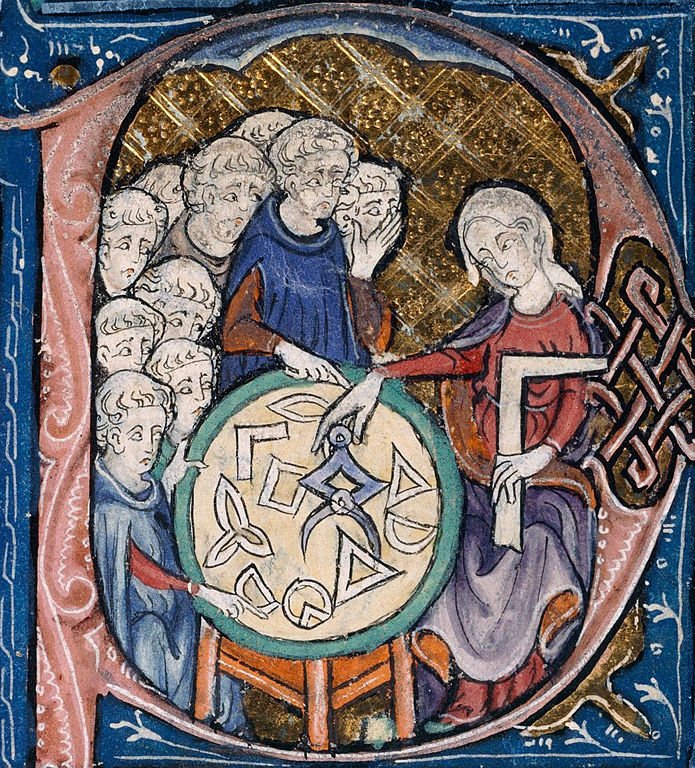Seven Days and Seven Sisters
It is always a little sad when a culture, as if due to a head injury, suffers memory loss. I will use two rather small examples: one of Seven Days and the second of Seven Sisters.
The first example comes of the famous Mother Goose rhyme about the Seven Days when a child is born. Note the fate of Tuesday’s Child is to be full of grace. What does it mean?
Below is the commonest variant, appearing first in Traditions of Devonshire by A.E. Bray, 1838.
Mrs. Bray comments: ‘The fortunes of children are likewise considered to be very much regulated by the day on which they were born. Here is a poetical adage on the subject common in our town’
Monday’s child is fair of face,
Tuesday’s child is full of grace,
Wednesday’s child is full of woe,
Thursday’s child has far to go,
Friday’s child is loving and giving,
Saturday’s child works hard for a living,
And the child that is born on the Sabbath day
Is bonny and blithe, and good and gay.
The poem exists in several variations. Below is one published in 1873, fifty years later, in Scribner’s St. Nicholas Magazine.

In the picture, we see Monday’s child primping, Tuesdays’ child striking a pose from the ballet, Wednesday is dancing a jig, Thursday sits depressed, head down, Friday puts a comforting hand on the shoulder of Saturday, who is baring a bundle of faggots. Meanwhile Sunday stands perched above all, hands crossed in a traditional Christian gesture of humility.
I note that the fate of Wednesday’s Child is swapped from being woeful to merry, whereas Thursday’s is swapped from success to sadness. I take “far to go” as in phrases like “he’s going places” or “he’s going to go far” means he is destined for success.
But the artist for St. Nicholas Magazine interprets Tuesday’s Child as gifted with gracefulness.
This is odd, because that is not the sole meaning of the word, nor, in the centuries past when Mother Goose collected the rhyme, was that the primary meaning. The primary meaning has been largely forgotten.
Having seen half a score or more writers explaining of the meaning of the rhyme, where Tuesday’s child is full of grace, I note that none of them, not one, interprets “grace” in the older sense of receiving a gift, or the theological sense of receiving a gift from God.
Worse, at least one writer did not know that “fair of face” meant “beautiful” and thought it meant “pale.” At least none of them was so foolish as to misread the line where Sunday’s child is fair and wise and good and gay.
To me, the rhyme scheme seems quite obvious, namely, that each couplet is a pair of contrasts: Wednesday’s “full of woe” is fated for failure whereas Thursday’s “far to go” for success; likewise Friday’s “giving” means wealth, whereas Saturday’s “works hard for a living” means want.
If so, I would venture that the poem means to contrast Monday’s child, blessed with outward beauty as Venus, with Tuesday’s, endowed with spiritual grace hence inward beauty, like the Virgin Mary.
Speaking of which, the phrase “full of grace” is the commonest English translation of the greeting by which the archangel addresses the Virgin Mary at the Annunciation. For reasons not hard to guess, the King James translators give the greeting as Κεχαριτωμένος as “highly favored”, an interpretation that remains controversial to this day.
I rather suspect that in Devonshire of 1838 the controversy both burned hotter and was kept quieter, for in those days questions of faith were taken seriously by all sides; but I rather doubt the meaning of the phrase was lost on anyone.
Noodling about online, I do not even see any other writer who makes a mention on the topic mentioning the older and deeper meaning of the phrase “full of grace” in this Mother Goose Rhyme.
It is forgotten.
Here is a second example of cultural amnesia at work.
I came across this blog post by scholarly gentleman commenting on the amnesia of another, while not grasping his own amnesia.
With admirable humility, the scholar confesses that he suspects himself to be an impostor, one who knows less than he pretends, but that many academicians feel likewise. He fears that what knowledge he has is trivial, generally known to everyone hence not worth mentioning. Then he saw an example showing otherwise.
The words below are his:
I came across the following medieval illustration and its accompanying tweet.

Geometria Source: Wikimedia Commons
The tweet: “Woman teaching geometry to monks. In the Middle Ages, it is unusual to see women represented as teachers, in particular when the students appear to be monks. Euclid’s Elementa, in the translation attributed to Adelard of Bath, 1312.”
The humble scholar comments:
I would simply have assumed that everybody knew what this picture represents and not commented. It is not a “women teaching geometry to monks” as the tweeter thinks but a typical medieval personification of Geometria, one of the so-called Seven Learned Sisters.
The Seven Learned Sisters are the personifications of the seven liberal arts, the trivium (grammar, rhetoric and dialectic) and the quadrivium (arithmetic, geometry, music and astronomy), which formed the curriculum in the lower or liberal arts faculty at the medieval university.
The humble scholar goes on to explain that this fourfold division of the mathematical sciences can be traced back from Proclus to the Pythagoreans. Arithmetic, studies quantities as such, music the relations between quantities, geometry magnitude at rest, spherics [astronomy] magnitude inherently moving.
But the most influential work on the seven liberal arts is the De nuptiis Philologiae et Mercurii (“On the Marriage of Philology and Mercury”) of Martianus Capella, which embellished each science with the figures of queens, each adorned with symbols of her realm.
Similar symbols can be found in old illustrations and statues of the Seven Learned Sisters.
Trivium:
- Grammar is a matron in a Roman cloak, carrying a closed vessel on a plate and a golden file. Inside the vessel are medicines for correcting faults of pronunciation, memory, and attention of young children; the file cleaned their teeth and tongues to clarify speech.
- Dialectic is a sharp-eyed maiden in an Athenian cloak, carrying a serpent and a hook. Anyone caught in the hook of her logical argument is drawn into the coils of the serpent and crushed. Other images have her bearing a laurel branch.
- Rhetoric is tall and regal queen, like Athena, armed and armored with breastplate, helm and sword. She bears a scroll.
Quadrivium:
- Geometry is a matron carrying a measuring rod and calipers draped in a purple peplos adorned with images of stars, but her shoes are tattered from circumnavigating the world.
- Arithmetic has rays of light darting from her forehead that she multiplies and divides according to the Pythagorean decade. Her outer robe conceals the operations of nature recorded discreetly on her undergarment. She carries a counting tablet.
- Astronomy bears an armillary sphere and sextant, and wears a set of golden wings.
- Music carries a shield, which is adorned with the concentric circles representing the music of the celestial spheres.
The humble scholar goes on to say that the figures of the Seven Learned Sisters were more than just a female name associated to a discipline of study. Each was a fully formed female character.
He then adds:
This of course raises the question, at least for me, why the mathematical disciplines that were taught almost exclusively to men in ancient Greece, the Romano-Hellenistic culture and in the Middle Ages should be represented by women. Quite honestly I don’t know the answer to my own question.
His honesty is as honest as it is painful. As I said, he confessed himself to be an impostor. It is ironic as it is admirable. He is an frank fake, who does not hide the fact that he is hiding the facts about himself.
I assume that it relates to the nine ancient Greek Muses, who were also women and the daughters of Zeus and Mnemosyne. This however just pushes the same question back another level. Why are the Muses female?
My Comment:
Since I went to a school that studied the trivium and the quadrivium, like the humble scholar, I am prone to suppose that all men who study liberal arts know what those arts are, and would see no need to explain the reference. It is sad that this supposition is wrong.
The answer to the question of why the Seven Learned Sisters are pictured as female has to do with the nature of the feminine spirit, which the moderns, who are colorblind to spiritual things, have largely forgotten.
The Seven Sisters are female because we scholars who study these arts love them. The learning is fair and fertile as a young bride, and we scholars are wedded to them.
The humble scholar asks why the Nine Muses are female.
This is a sad question. He is a stranger to his own heritage. He has been robbed.
I call him humble when he calls himself an impostor, not because he is not an impostor, but because, if he is anything like the academics of the modern age, his imposture is not of his own contrivance. It was imposed on him.
The academics of the modern age are taught tattered leftovers for learning: instead of Grammar, Newspeak, instead of Rhetoric, Talking Points, instead of Logic, Doublethink.
For Arithmetic, the modern academic is taught to repeat the statistics supporting the Consensus of Expert Opinion. For Geometry, meant to measure the world, he is given the Lesbian Rule, which bends as needed, for making man the measure of all things. For Astronomy, he is taught Climate Change and Eco-Scaremongering; for he numbers not the stars, but instead counts down the days until the world ends. Instead of learning about the Music of the Spheres, he learns Activism.
Instead of queens adorned with globes and swords, harps and measuring rods, the Seven Sisters of modernism are lewd harlots armed with hot irons to blind the victim, and rightly figured as riding the seven-headed beast of political power, with blasphemies written on their heads, bearing up cups of pollution and filth.
Behold thy brides, ye learned men, and despair.
I see our humble scholar here, a learned man, had learning taught to him with important parts left out, and so he was awarded the credentials of his indoctrination officers disguised as teachers. But his professors robbed him of his patrimony, and so he has none to pass along to his students in turn.
Why are the Muses women?
The answer for poets, as with scholars, is love.
To be inspired is, shall we say, a seminal act, a type of ravishment, and the embrace is ecstatic brings forth abundantly. Men write poetry for two reasons: (1) to seduce women (2) because we cannot bear children, and poetry is a substitute act of creation.
Poetic inspiration is a divine madness. It comes from women, is directed toward woman, and it makes the poet (the word means “maker”) stand in the role of a woman, and feel the fool.
What other thing in hell, earth, or heaven could represent divinity and madness and birthing a new creation, other than a woman? For whom else do we make ourselves so cheerfully into fools?
I mean no disrespect to any scholars, humble or not, but such boys need to get out more, and talk to some poets.
Are there any left in the West?
